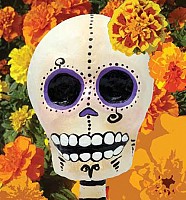Curriculum Resources
« Go Back

El Día de los Muertos - History and Customs (English)
This guide gives a colorful historical overview of how el Día de los Muertos is celebrated in some Latin American Countries. In the 16th century Spaniards brought the Catholic celebration of Día de los Muertos to Latin America where it mixed with indigenous rituals honoring the dead. Today, people across Latin America honor their dead and celebrate the cycle of life in early November under a variety of names: “Día de los Muertos” (Day of the Dead), “Día de los Todos Santos“ (All Saints Day), “Día de los Difuntos” (Day of the Deceased), and “Día de los Angelitos” (Day of the Little Angels in honor of children who have died).
In general, families begin the morning of November 1 by constructing altars to honor their deceased loved ones. They place photographs and favorite foods of the dead, candles to light the way, incense, and other gifts on the altars. The celebration then shifts to the cemetery where all gather around the graves of relatives. Families carefully clean and sweep the gravesites, and decorate them with colorful adornments, such as streamers, flowers, crosses, candles, and food—all of which serve as offerings to attract and please ancestors. By early afternoon, the cemetery fills with people joyfully celebrating life and death by playing music, dancing, and feasting alongside the spirits of their ancestors.
Check out this guide that covers traditions in Mexico, Guatemala, and Bolivia. Available in English and Spanish.
